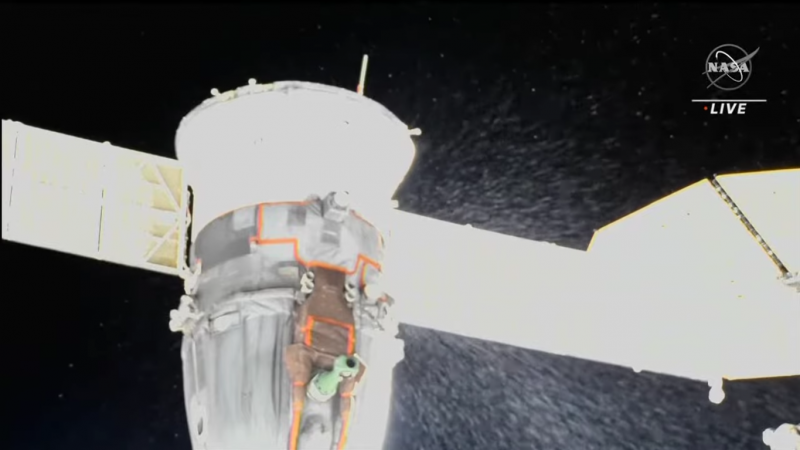Thrusters functioning on leaky Soyuz at ISS
Thrusters on a malfunctioning Soyuz crew capsule docked at the International Space Station are in good working order, NASA reported Friday (December 16, 2022). Soyuz MS-22 – which carried Russian cosmonauts Sergey Prokopyev and Dmitri Petelin, along with US astronaut Frank Rubio to the ISS in September – began leaking coolant Wednesday (December 14), as the cosmonauts were preparing for a work session on the station’s exterior.
Remaining Soyuz systems OK
NASA also said the crippled capsule’s navigation system seems to be working, for now:
As part of the ongoing evaluation and investigation, Roscosmos flight controllers conducted a successful test of the Soyuz MS-22 thrusters at 3:08 a.m. EST Friday, Dec. 16. The systems that were tested were nominal, and Roscosmos assessments of additional Soyuz systems continue. Temperatures and humidity within the Soyuz spacecraft, which remains docked to the Rassvet module, are within acceptable limits.
Those thrusters are critical for Soyuz MS-22’s return to Earth. Whether it goes home early or empty – with a replacement Soyuz sent up on autopilot – is still being discussed, reports Eric Berger, senior space editor for Ars Technica:
So here’s something I’ve not shared on Twitter or anywhere else. Roscosmos is seriously considering bringing the crew of Soyuz MS-22 (including NASA’s Frank Rubio) home early, as in a week or two. The rationale: The Soyuz flight computer is not overheating now, but the longer it remains on ISS without external cooling, that could change. They are also considering bringing up Soyuz MS-23 autonomously and jettisoning MS-22. No final decisions have yet been made. Meetings are ongoing.
The cause of the leak remains unknown, though a strike by space junk or a micrometeor is likely.
Russian ISS spacewalks on hold
NASA said the sudden leak forced the cancellation of the planned Russian spacewalk:
… Ground teams noticed significant leaking of an unknown substance from the aft portion of the Soyuz MS-22 spacecraft docked to the Rassvet module on the International Space Station. The spacewalk has been canceled, and ground teams in Moscow are evaluating the nature of the fluid and potential impacts to the integrity of the Soyuz spacecraft. …
The unknown substance was later identified as liquid coolant from the capsule’s external cooling loop. The leaking material made for eerily beautiful imagery, as droplets froze into what looked like a space-based snowstorm. NASA captured the scene during a live broadcast of the spacewalk.
The canceled spacewalk, as well as a second Russian spacewalk planned for December 21, are now on indefinite hold, NASA reported. Roscosmos will reschedule the work sessions once the leak has been fully evaluated.
Solar array installation at ISS on Wednesday
Meanwhile, day-to-day duties continue on the ISS, as US crewmembers prepare to install the ISS Roll-Out Solar Array (iROSA). Delayed by the leak evaluation, that mission is planned now for Wednesday (December 21, 2022), a loss of two days.
The crew aboard station completed normal operations Thursday, including participating in science investigations and research, as well as configuring tools ahead of a planned U.S. spacewalk on Monday, Dec. 19. Specialists are working through robotic plans ahead of Monday’s spacewalk to best optimize for upcoming station operations and the Soyuz inspection.
According to NASA, the new solar arrays, a set of which are already in place at the ISS, represent a step forward in power production in space:
These arrays are a compact design, more affordable, and offer autonomous capabilities that can enhance a wide spectrum of scientific and commercial missions, from low-Earth orbit all the way to interplanetary travel. ROSAs recently installed aboard the International Space Station provide additional power to augment the existing power supply, supporting more cutting-edge scientific research.
Live coverage of Wednesday’s spacewalk begins at 6:30 a.m. ET (11:30 UTC) on NASA TV. The spacewalk is scheduled to start at 7:40 a.m. ET (12:40 UTC). Times and dates are subject to change as the situation develops aboard the ISS.
Bottom line: Flight controllers continue to evaluate a coolant leak aboard a Soyuz capsule docked at the ISS.



